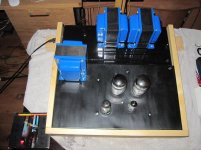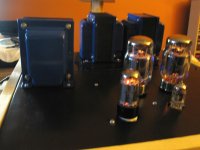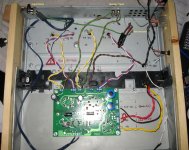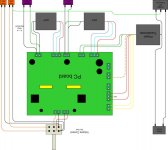Checked my DVM with another resistor of known value underneath the 200K scale, and it's fine, so the DVM is ok.
I am putting the amp build on standby mode right now as I am reluctant to carry on with what appear to be two defective or mislabeled resistors.
I will probably take it up again by replacing the PCB resistors on Tuesday or Wednesday when the parts arrive.
In the meantime, happy independence day to our Southern friends.
I am putting the amp build on standby mode right now as I am reluctant to carry on with what appear to be two defective or mislabeled resistors.
I will probably take it up again by replacing the PCB resistors on Tuesday or Wednesday when the parts arrive.
In the meantime, happy independence day to our Southern friends.
Hi All,
I just finished my tubelab sse amp, I used Edcor xpwr002-240 power transformer,Edcor gxe15-6-5k opt. for tube I used 5ar4 (sovtek) rectifier, ecc81(mulard), 6ca7(Electro harmonix). I run the amp, its sound very good but when I turn up the volume the right channel start destorting, is there any one who can tell me what could be the problem.
Thanks everyone.
Rana from Bangladesh
I just finished my tubelab sse amp, I used Edcor xpwr002-240 power transformer,Edcor gxe15-6-5k opt. for tube I used 5ar4 (sovtek) rectifier, ecc81(mulard), 6ca7(Electro harmonix). I run the amp, its sound very good but when I turn up the volume the right channel start destorting, is there any one who can tell me what could be the problem.
Thanks everyone.
Rana from Bangladesh
Crap, my 150K resistors at R4 and R2 are reading 17K and 9K respectively unless it's my DVM which has crappy readings at 200K scale...
Did you lift one end of the resistors from the board before measuring? Why were you measuring the resistors? Just curious....
Damn Denny, I forgot about that since the circuit flow can alter the readings. Will do that and check again.
I wanted to verify against doing any silly mistake like a bad component, but in the end maybe the verification itself had a silly mistake.
If they're all right, then I can proceed with the rest of testing today itself, yeah!
Thanks Denny!
I wanted to verify against doing any silly mistake like a bad component, but in the end maybe the verification itself had a silly mistake.
If they're all right, then I can proceed with the rest of testing today itself, yeah!
Thanks Denny!
Damn Denny, I forgot about that since the circuit flow can alter the readings. Will do that and check again.
I wanted to verify against doing any silly mistake like a bad component, but in the end maybe the verification itself had a silly mistake.
If they're all right, then I can proceed with the rest of testing today itself, yeah!
Thanks Denny!
Just a note on how I do it. There's many parts all in a bag so it's easy to mix them up. What I do is BEFORE I install a part like a resistor, I do an Ohms test with the DMM before I install. I've been doing this for some time now and I still do it. I'm to the point where I can ID stripes on the resistors but one stripe off and it's the wrong part, test with DMM before solder, it will save a bunch of time down the road if you put the wrong resistor in.
Oh yeah - we are heading up to Canada eh? (cottage country Ontario) next week, my favorite place in this whole wide world! Gonna set up a SSE tube amp for listening on the swimming dock! Yeah u right!

My.02
Cheers,
Bob
Last edited:
Sound tip, Bob.
Enjoy the trip to Canada!
Made some dummy load using resistors, and a wet towels ready if any fire should start.
Did all continuity testing for the primary power, then the ground testing for all metal, touchable points.
After that, I did all the steps in Ty's instructions, and got a full ok.
The only thing that bugged me after this was one input jack not staying put. I got very flimsy and cheap input jacks, so had to unsolder and re=solder those and they still don't fit well - had to use a DIY rubber part to try and keep it in place.
After that, my DAC was misbehaving, but I hadn't noticed, so I thought we had distortion and hiss.
After DAC power cycle, it's alive and well!
Worked first time, huge sound, much, much better than I expected, even at the higher frequencies. Looking forward to adding the motor run cap.
Pics, with a Depeche Mode Black Celebration CD for scale:
Enjoy the trip to Canada!
Made some dummy load using resistors, and a wet towels ready if any fire should start.
Did all continuity testing for the primary power, then the ground testing for all metal, touchable points.
After that, I did all the steps in Ty's instructions, and got a full ok.
The only thing that bugged me after this was one input jack not staying put. I got very flimsy and cheap input jacks, so had to unsolder and re=solder those and they still don't fit well - had to use a DIY rubber part to try and keep it in place.
After that, my DAC was misbehaving, but I hadn't noticed, so I thought we had distortion and hiss.
After DAC power cycle, it's alive and well!
Worked first time, huge sound, much, much better than I expected, even at the higher frequencies. Looking forward to adding the motor run cap.
Pics, with a Depeche Mode Black Celebration CD for scale:
Attachments
Last edited:
Glad you're up and running. But, wet towels and electrical fires usually don't mix well.
Hehe, fortunately there were neither, but I wasn't planning to touch electric wires with it.
Had a good listening session yesterday, and the full range sounds sweet. No bass nor treble lacking, mid-range is detailed - vocals appear more forward.
I was very impressed with the resolution of fast attack transients - this amp is going to be awesome with percussion and strings (thinking guitars and the like here).
It seems the sound is more room-filling, as if there were sources between the speakers and the listener.
I have some low-pitched hum which appears after a few seconds on powering up, but other than that, the sound is amazing as is, even with my affordable Solen caps and affordable Russian tubes. The only thing I have not restrained myself with are the big Edcors. Perhaps a choke is needed here. Maybe I will add the motor run cap.
Mechanically, I'll perhaps add the convection holes as the amp heats up a lot and I am also thinking of the feet to help with heat dissipation and stability/vibration.
Additionally, the IEC plug isn't secure in its opening, it seems the screws are resting on empty, and I am disappointed with the input jacks and speaker terminals (that's what you get when you hunt for lowest cost) so that I will probably replace them with more durable and solid ones. This morning for instance, I probably have some short internally as the left output isn't working (the left KT-88 seems fine).
Feature-wise, I think I'll enjoy the amp as it is for a good while, until I try the UL mode implementation, a subwoofer out, micro-processor monitoring and power-up sequence and so on, with tube-rolling and cap-rolling and other tweaks much further down the line if at all.
A friend of mine who is big in audio DIY mentioned using an interstage transformer instead of resistor + cap, and hence maybe one day I'll experiment with that, but this would require some PCB or wire hacks, so it's not for now.
Last edited:
Put a choke (remove resistor) and aux cap in there and hook it up with cathode feedback and UL mode, it will sound even better. No need for any inter stage transformer in this circuit with these tubes. If it was a REAL triode amp with triode tubes maybe, but not this circuit. Maybe your friend wants to help you build another amp like he suggests. Regarding hum - usually it's related to wire lead dress (the way you installed all the wires) and/or RCA jacks be sure they are installed tight and not grounded to the chassis.
Cheers,
Bob
Cheers,
Bob
Left Channel is dead!
Tried reviving the left channel, noticed the input ground was disconnected, so re-soldered it, but the left channel is still dead.
I think this happened yesterday when disconnecting the input, there was a weird screeching sound, most probably a short between output and input ground or something similar: my input and speaker terminals are right next to each other vertically.
Have I burned a component? Not the left OPT hopefully? Not sure how I am going to troubleshoot this.
If I need to replace one, I might as well order new input jacks, new speaker terminals, the choke and other parts at the same time.
Circuit pics from today:

Put a choke (remove resistor) and aux cap in there and hook it up with cathode feedback and UL mode, it will sound even better.
Regarding hum - usually it's related to wire lead dress (the way you installed all the wires) and/or RCA jacks be sure they are installed tight and not grounded to the chassis.
Tried reviving the left channel, noticed the input ground was disconnected, so re-soldered it, but the left channel is still dead.
I think this happened yesterday when disconnecting the input, there was a weird screeching sound, most probably a short between output and input ground or something similar: my input and speaker terminals are right next to each other vertically.
Have I burned a component? Not the left OPT hopefully? Not sure how I am going to troubleshoot this.
If I need to replace one, I might as well order new input jacks, new speaker terminals, the choke and other parts at the same time.
Circuit pics from today:
Looks like my DAC's left channel was damaged with the short on the left channel from the amp, which wasn't connected to ground.
I don't think I'll be able to revive the left channel on the DAC myself.
I don't think I'll be able to revive the left channel on the DAC myself.
Looks like my DAC's left channel was damaged with the short on the left channel from the amp, which wasn't connected to ground.
I don't think I'll be able to revive the left channel on the DAC myself.
Un-hooking inputs on a tube amp with amp powered on = recipe for disaster. Most likely blown tweeters on your speakers is the most common problem.
Only takes 30 seconds - power off wait 30 secs swap cables power on (as long as you have the diodes and CL90 installed that is, otherwise go get a cup of tea and wait a few minutes to power on. It's a lot easier than replacing speaker parts etc.
Cheers,
Bob
Fortunately, the speakers appear fine. My DAC cannot provide a loud enough channel though either RCA or headphones out.
Last edited:
Edcor CXSE Cathode Feedback wiring.
Planning to wire the Edcor CXSEs for Cathode Feedback, since I don't have a choke. I don't know if the wires should be inverted or not for the Edcors.
Planning to wire the Edcor CXSEs for Cathode Feedback, since I don't have a choke. I don't know if the wires should be inverted or not for the Edcors.
I think I should go for UL mode first before CFB, but the thing is, I wired my OPT as in the configuration with choke, so I have to check that as well and I probably thus have a ground loop which explains the hum.
So for today, I already installed new salvaged RCA inputs jacks, and will need to do the wiring to them, then I am going to check that Ultra-Linear implementation.
It's not too easy to follow on the wiring page, I would have preferred some text description of what to disconnect from the terminals and what to connect when going from normal triode to UL, but I believe I should manage.
So for today, I already installed new salvaged RCA inputs jacks, and will need to do the wiring to them, then I am going to check that Ultra-Linear implementation.
It's not too easy to follow on the wiring page, I would have preferred some text description of what to disconnect from the terminals and what to connect when going from normal triode to UL, but I believe I should manage.
From what I gather, going from triode to UL mode necessitates that the jumper for the OPT primaries be removed from the PCB, and instead, the Edcor CXSE OPT primary White/Blue (Screen), corresponding to the Tubelab cyan wire in the wiring diagram is wired in the middle of the 3-prong terminal for each.
Last edited:
The hardest part is to be sure you are using the correct wire diagram for the way you built your amp and then follow along. Try it and let us know or take a pic and post it...
Cheers,
Bob
Cheers,
Bob
Hi Bob,
Looks like the circuit pic I tried to post last time didn't go through. We needed a new one so here it is below.
I have rewired new input jacks on the upper left so that there's no possibility of shorting between the output at the speaker terminals and the input, unwired the grounds to the speaker terminals, made the OPT go to the PCB for CFB (my girlfriend would have laughed at me right now with this 'acronymese', but she loves what I'm doing - she's cool like that), and also removed the little jumpers to implement ultra-linear mode (the Edcors are tapped at 40% based on the docs). Had a lot of fiddling to do with the terminals to accommodate the two wires.
It blew the fuse on power up, so it's either I have a short somewhere or the fuse didn't cut it. Today I'll check for shorts and also try to find an appropriate fuse with about 2A. Of course, if you find anything fishy, let me know, please, thanks.
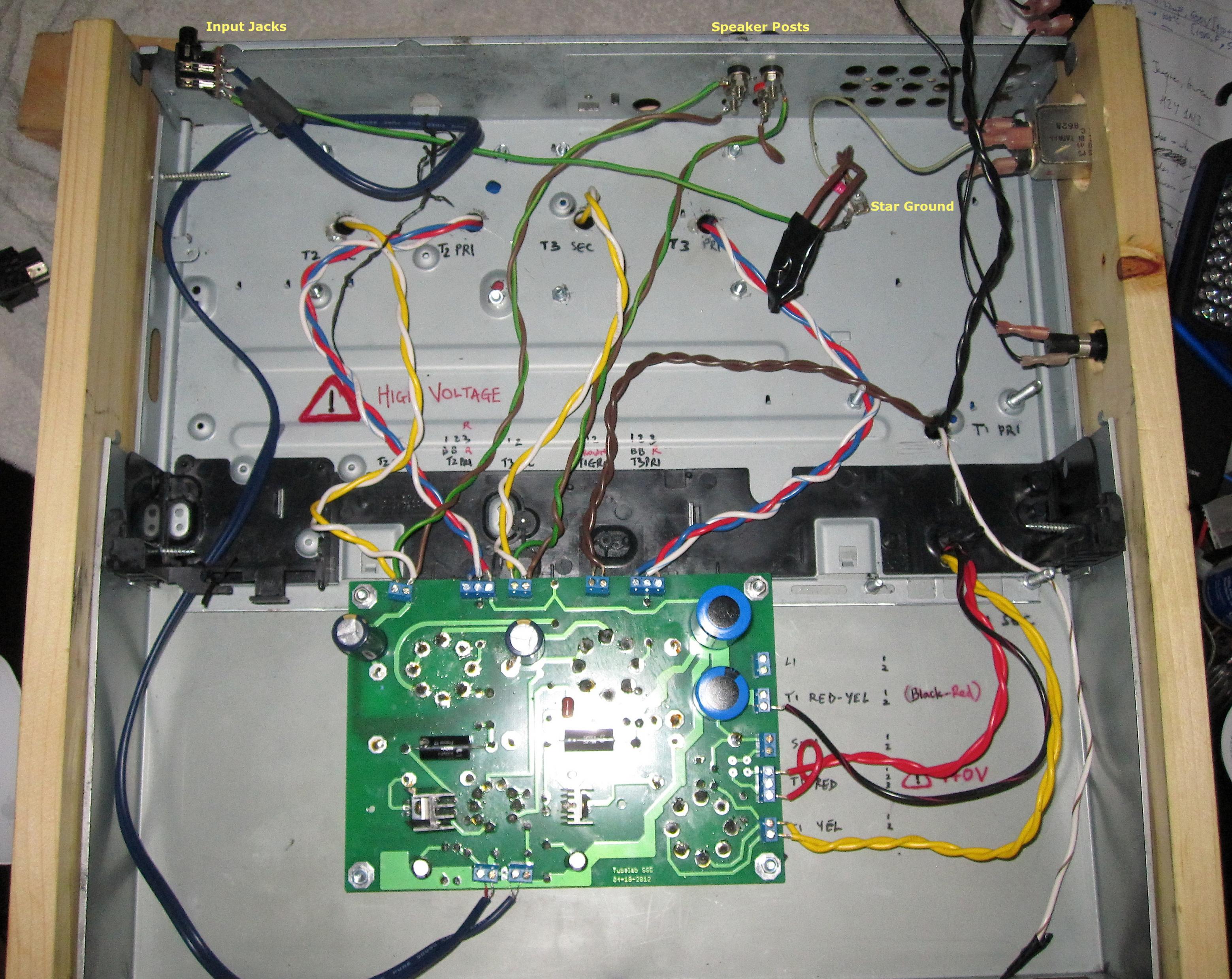
Looks like the circuit pic I tried to post last time didn't go through. We needed a new one so here it is below.
I have rewired new input jacks on the upper left so that there's no possibility of shorting between the output at the speaker terminals and the input, unwired the grounds to the speaker terminals, made the OPT go to the PCB for CFB (my girlfriend would have laughed at me right now with this 'acronymese', but she loves what I'm doing - she's cool like that), and also removed the little jumpers to implement ultra-linear mode (the Edcors are tapped at 40% based on the docs). Had a lot of fiddling to do with the terminals to accommodate the two wires.
It blew the fuse on power up, so it's either I have a short somewhere or the fuse didn't cut it. Today I'll check for shorts and also try to find an appropriate fuse with about 2A. Of course, if you find anything fishy, let me know, please, thanks.
Attachments
- Home
- More Vendors...
- Tubelab
- SSE first build, caps and other questions.
